Bug (short for Bebe pug) is my 11-year-old second-born daughter. (The first being my 12-year-old pug, Chinki.)
She’s a purebred, born from a line of AKC champion pugs, but with that came the typical hereditary joint diseases of overly bred “perfect” pugs.
Don’t get me wrong; Bug is perfect in every which way and I wouldn’t trade her in for anything. But raising her these last few years, especially, has taught me a lot about dog health and nutrition as both my girls settle into their senior years.
Just before she turned 8, Bug started showing signs of degenerative joint disease. Her hips would give out a little every time she walked.
She grew up in one-story homes with hard floors, and after the move to our 1920s original bungalow, the split-level rooms and terraced yard seemed to exacerbate her condition.
Disclosure: If you shop from my article or make a purchase through one of my links, I may receive commissions on some of the products I recommend.
Over the years, her weak hips eventually gave out and she lost the use of both of her back legs.
At home, she moves around by dragging her body with her front legs. (She has the strongest front legs of any dog I know!)
When she’s out and about, she rolls around in a dog wheelchair and we can barely keep up with her. I almost expect her wheelchair to have flame decals!
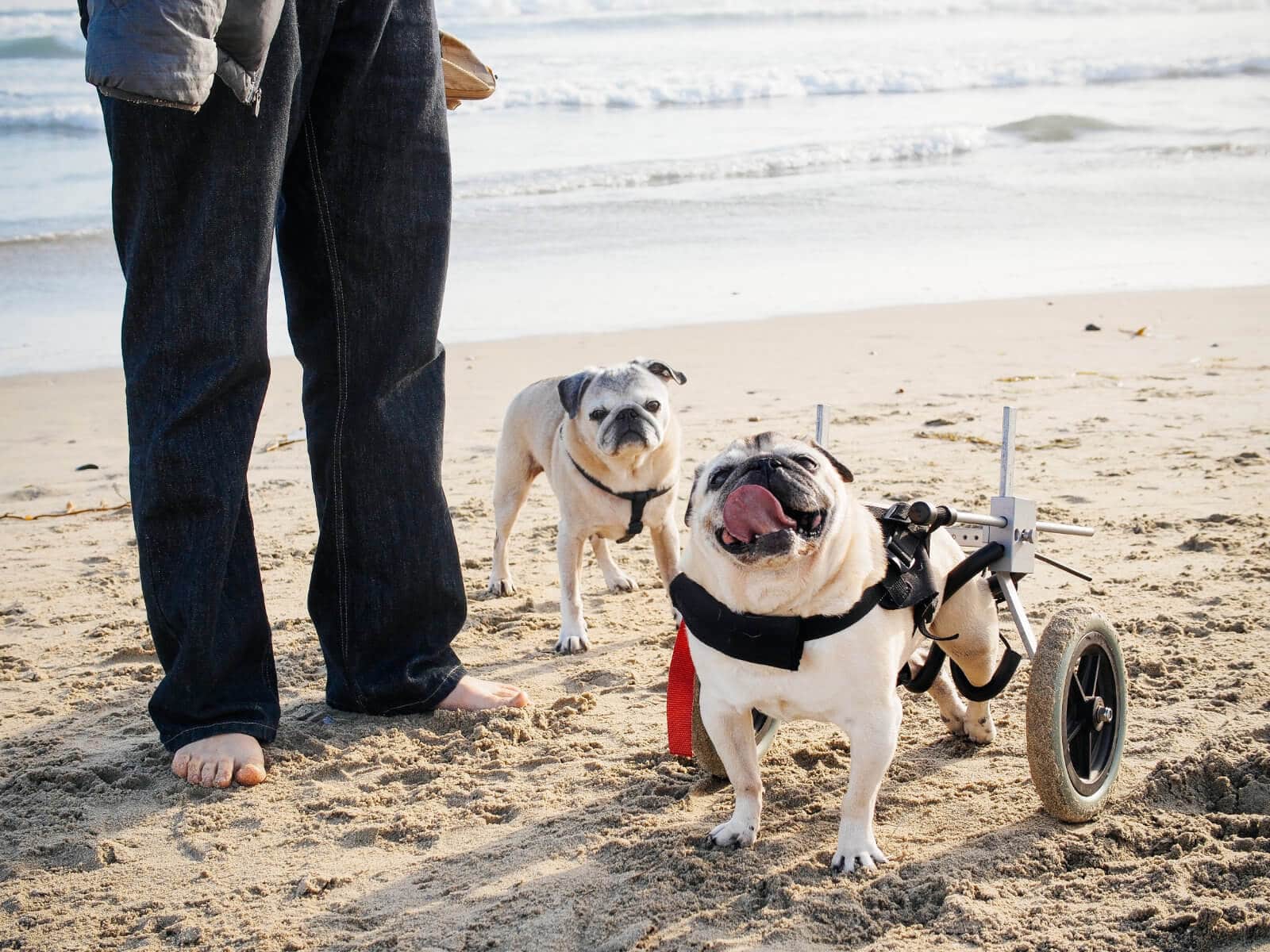
If you just saw her sitting, you wouldn’t know that she had a handicap. She’s full of smiles and high spirits, and doesn’t seem to realize that she can’t walk on all fours like her sister can. She’s still a speedy little thing, especially when it’s meal time or beach day!
Bug wasn’t always like this though. In the month that her hip dysplasia finally advanced, she was weak, tired, frustrated, and we thought for a moment that we were going to lose her.
Since she no longer had control of her hips to squat and potty, she became incontinent for a few weeks. With her age, and the fact that she showed no pain in her joints (just lameness), we opted to skip any kind of corrective surgery and approached her condition more holistically.
One of our changes was in diet.
Please note: This information, based on my own opinions and experiences, is not intended to replace professional medical advice. Every dog’s dietary needs are different. Please consult with your veterinarian and use personal judgment when applying this information to your own dog’s diet.
Cooking our way to a healthier dog diet
Ever since I started raising my own dogs, I’d always wanted to make their food at home but thought it would be too expensive or too time-consuming, or that they wouldn’t get the nutrition they needed.
During the month of Bug’s doggy depression, I vowed to make her precious life (or what I felt might have been the final stages) as comfortable as possible.
Both of my pugs had a range of health issues growing up, which I unfortunately found out were common for the breed.
My older one had persistent hot spots and itchiness that no commercial dog food could cure (and I’ve tried them all, from grain-free kibbles to lamb, veal, fish, and many more things she would simply spit out).
Bug was overweight for a while when she was younger, even though she ate the recommended amount of food for her target weight. Eventually, I settled on Wellness kibbles and they did well with that brand.
But, I wanted to explore other options. I wanted to give them real food—fresh, nutritious ingredients that I recognized and could even eat myself.
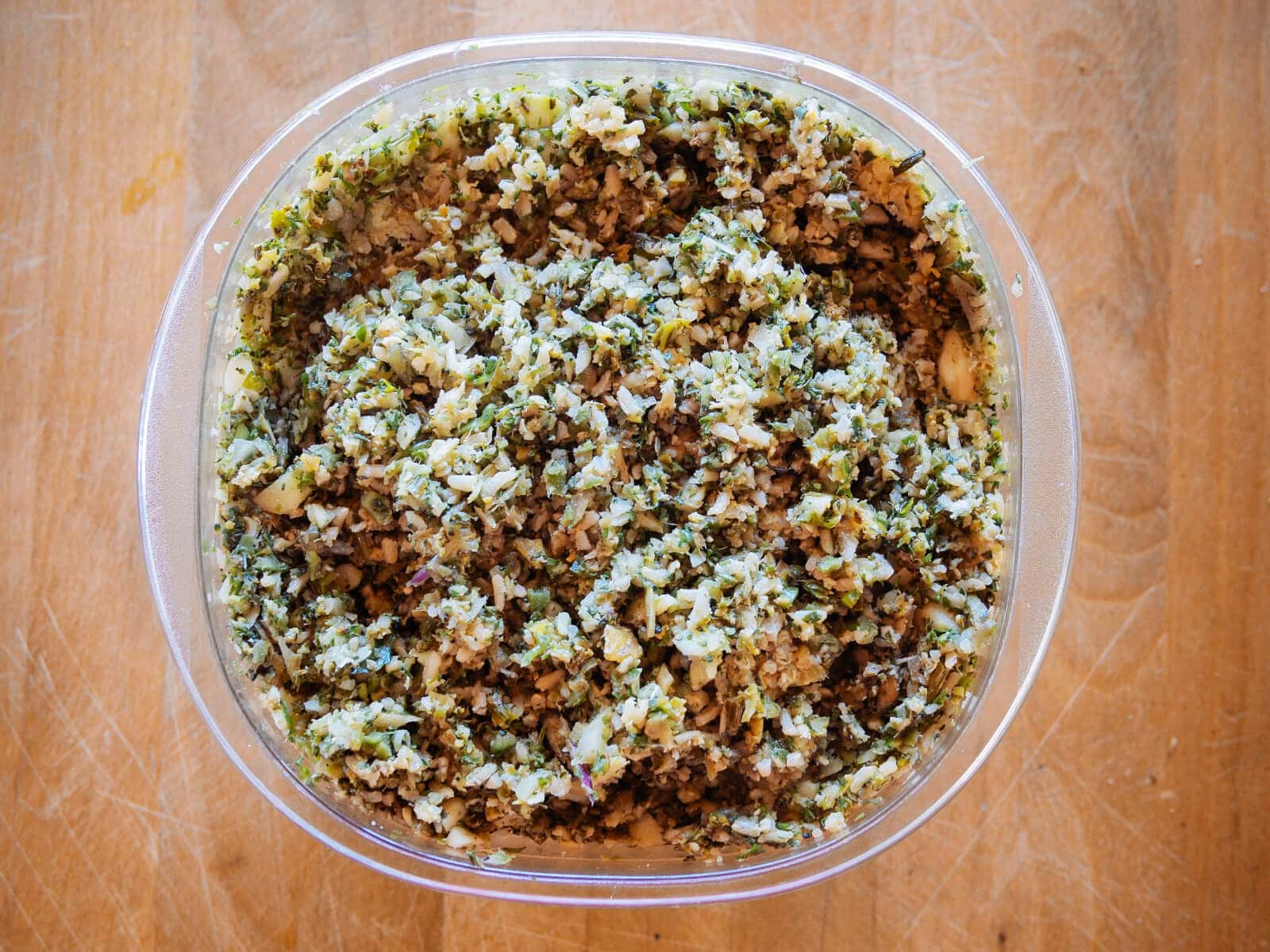
I’ve mentioned in my post on homemade whole grain chicken feed that the entire household (humans, dogs, and chickens) all share the same whole grains and seeds that we buy in bulk, as well as the bounty that comes from our edible garden.
Everything our animals eat, we can eat. (Well, I’ll admit that fig beetles and other bugs are not our thing, but our chickens love it!)
When it comes to homemade feed for our laying hens, we stick to a tried-and-true formula that works for every layer: 16 to 17 percent protein (determined by my chicken feed calculator), vitamins, minerals, and amino acids from a wide variety of grains and seeds, and free range of a pasture for weeds, greens, and insects.
These numbers vary depending on the age of your chickens, but for optimal health and egg production, it’s easy to devise a diet that fits within those parameters.
Dogs, on the other hand, aren’t bred for a standard function the way chickens are.
Like humans, dogs’ dietary needs can vary wildly based on age, breed, health history, and activity level. What works for one dog may not work for another.
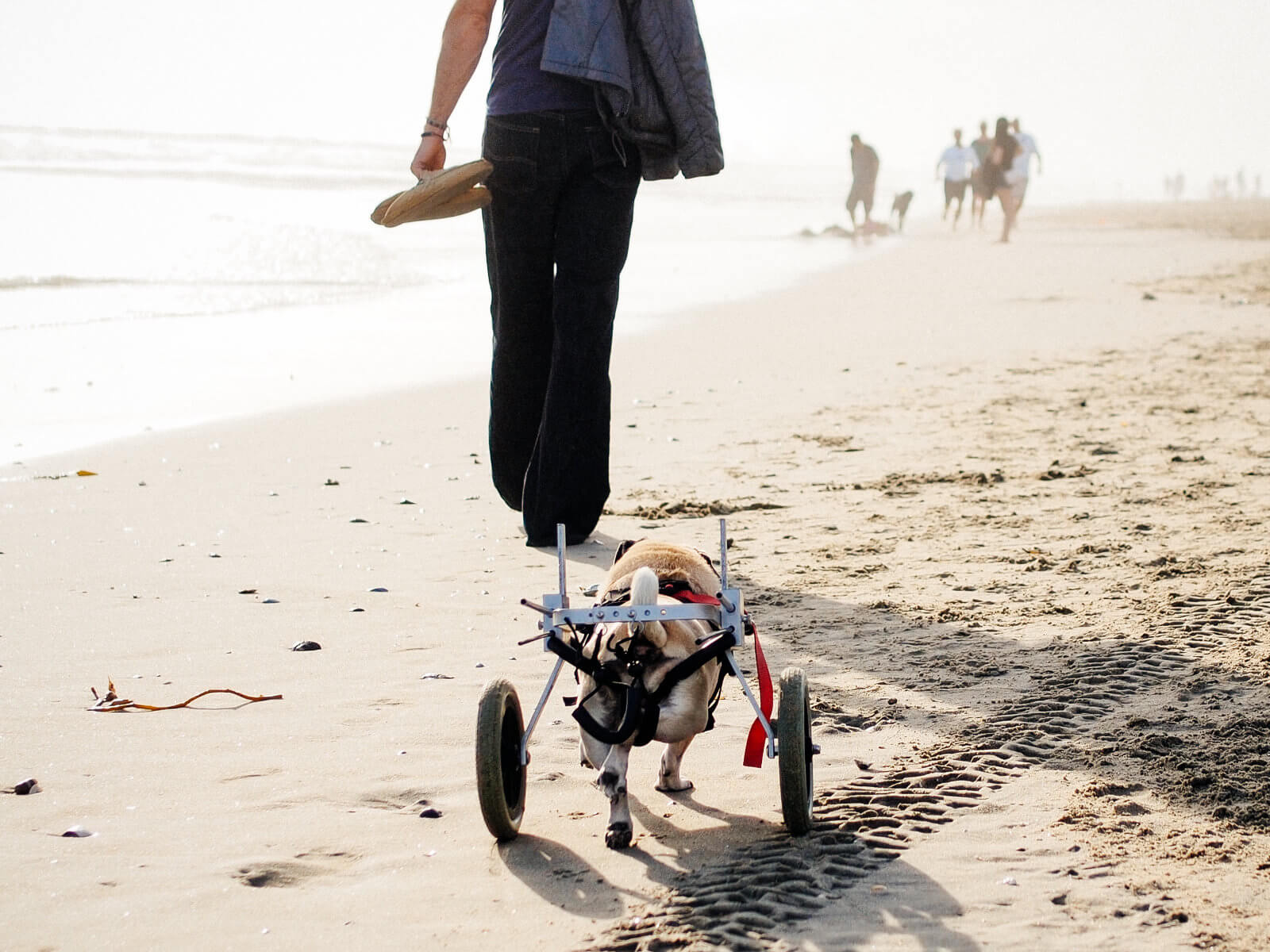
When I first started thinking about this post, I almost hesitated to share my recipe for homemade dog food since it’s so tailored to the needs of my pugs.
But, I wanted to show other dog owners that homemade, wholesome, healthy food is possible, and doesn’t take much more time than preparing your own meal in the kitchen.
Depending on how many dogs you have and how much they eat, you may only need to prepare their food once or twice a week.
A general guideline for preparing dog food at home
My DIY dog food recipe is more of a general guideline, rather than an exact meal plan that I follow each week. My dogs’ diet changes the same way ours does, depending on what we do and what we buy or grow.
However, we almost always stay with this basic formula:
- 50 percent cooked protein
- 25 percent raw vegetables
- 25 percent cooked complex carbohydrates
- Fats and supplements
- Eggshells
Protein is always meat and usually chicken, though we’ve also used turkey, pork, and beef. We feed any and all parts of the animals, but most commonly, we saute chicken breasts or chicken thighs in coconut oil and ground turmeric.
Coconut oil has a host of health benefits for dogs, such as improving the skin and coat, increasing energy, aiding digestion, reducing allergic reactions, promoting wound healing, preventing yeast and fungal infections, and supporting arthritis or ligament problems.
Turmeric has long been studied for its powerful medicinal properties, including its use as an antioxidant and anti-inflammatory.
We add it to the coconut oil since it is fat-soluble, and use it to support our pugs’ joint health. (Turmeric-spiced dark meat chicken happens to be quite delectable to a dog!)
Speaking of dark meat, we feed thighs and breasts interchangeably. While we’ll remove the skin from poultry and trim off excessive fat from red meat, we don’t worry about buying the leanest meat possible for our dogs.
A little fat is necessary for a well-rounded diet. (If your dog is prone to being overweight, you might want to stick with only lean meats.)
Raw vegetables come from whatever is currently growing in our garden. Sometimes we’ll even throw a few pieces of fruit in there, like in the fall when cranberries are in season. (Bug has a history of urinary tract infections, so we typically give her a cranberry supplement as a preventive measure.)
We vary the vegetables each week so the pugs don’t eat too much of any one thing. In one meal they might get broccoli, celery, fava bean leaves, radishes, and nasturtiums. Sometimes apples, bananas, or feijoas that we pick off our trees… and even herbs, like salad burnet, basil, or parsley.
This component provides fiber to support digestive health, as well as antioxidants and phytonutrients. In general, the darker the vegetable, the better it is nutritionally.
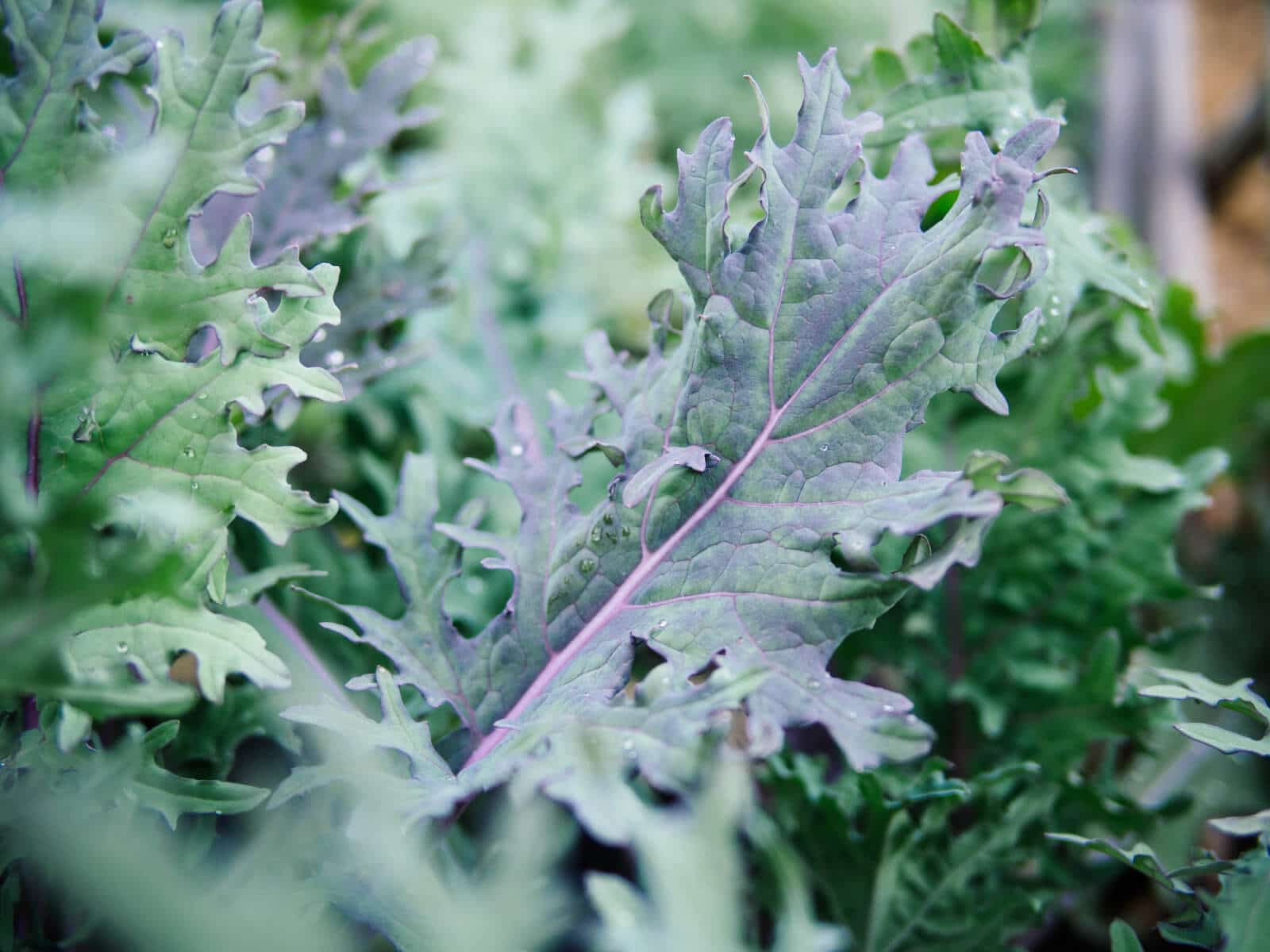
We feed our dogs all the same vegetables we feed ourselves, and this includes black kale, purple carrots, and green romanesco broccoli. They are garden foodies just like we are!
(But please don’t think you have to get this fancy for your homemade dog food recipe—we’re just able to give our pets all the excess that grows in our garden.)
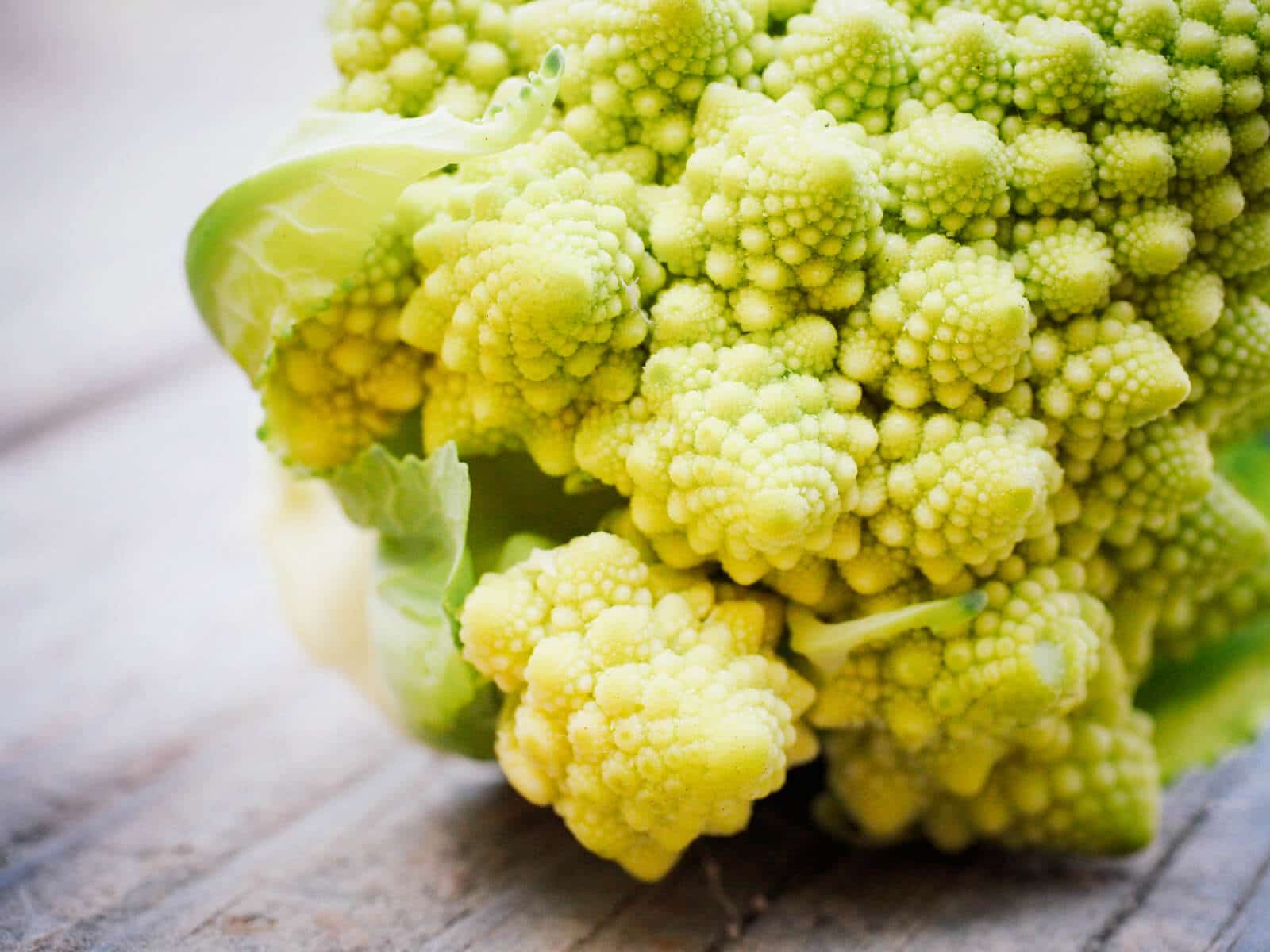
While this might sound like a lot, keep in mind that we only need small amounts of each vegetable—a few broccoli florets or stems, a rib of celery, a small handful of carrot tops.
They tend to be the “leftovers” in our produce bin, so we never have to buy, say, a whole head of cauliflower just for the dogs.

We usually focus on broccoli and broccoli leaves as the primary vegetables because they are exceptionally nutrient dense (particularly the leaves of the plant, which we grow in abundance at home).
A recent peer-reviewed medical study has found that a compound in broccoli, sulforaphane, helps slow the progress of osteoarthritis.
To a lesser extent other cruciferous vegetables, such as cabbage and brussels sprouts, also contain sulforaphane, but it’s most prevalent in broccoli. In our household, with two aging dogs, joint health is a priority.
Important note: The only vegetable we definitely do not feed our dogs is onion (and related alliums, like leeks and garlic), which contains a toxic compound called thiosulphate. Even if ingested in small amounts, thiosulphate can damage a dog’s red blood cells and cause hemolytic anemia.
Complex carbohydrates typically come from brown rice, wild rice (or any number of Asian rices the hubby and I make at home, like red or black rice), oats, lentils, split peas, or starchy vegetables like potatoes, sweet potatoes, and winter squash. Wild rice, split peas, and lentils, in particular, have the advantage of also being high in protein.
These complex carbs provide energy and aid in gastrointestinal function, so don’t think of them simply as filler. We switch up this component every week to give some variety, and sometimes combine a grain with a starchy vegetable (say, brown rice with sweet potatoes).
Fats and supplements round out our homemade dog food, and they’re very specific to our pugs’ health needs.
Eggshells (from their chicken sisters!) are an important source of calcium and added during the preparation of their food. (Unless you regularly give your dog raw meaty bones to chew on, you should always supplement with calcium.)

We dole out the rest of their requirements between two meals a day. Wild Alaskan salmon oil (for omega-3 fatty acids), liquid glucosamine (for joint health), and powdered cranberry extract (for urinary health) are given in the morning, while brewer’s yeast (for immune system support) and coconut oil (for overall health) are given in the evening.
Brewer’s yeast is also thought to be a natural method for controlling fleas, as its sulfur compounds purportedly make a dog less palatable to them.
(The jury is still out on that one, but I do believe in brewer’s yeast for its vast array of B vitamins; I even add it to my homemade corn-free chicken feed.)
Preparation of our homemade dog food
All of the information above might seem intimidating, but I assure you that making the actual meals for our dogs takes no more than 20 minutes of actual hands-on time.
First, we cook our complex carbs, whether they’re grains, legumes, or starchy vegetables.
While that pot is simmering on the stove, we cook the meat in a separate pan in coconut oil and ground turmeric. After it’s cooled a bit, we add chunks of meat to our food processor and pulse until they’re broken down into 1/2- to 1-inch pieces.
Then, we gather whatever vegetables or fruits we have in the kitchen (usually an assortment of five or more things), chop them up as needed, and toss them into the food processor.
We also add a few clean, crushed eggshells to the mix. A few pulses turns all this food into smaller pieces, making them more digestible for our dogs.
Finally, we add the cooled, cooked carbs to the food processor and do a couple more pulses to combine. Everything should have a finely crumbled texture by this point.
(If you have a heavy hand and accidentally make this mix on the mushy side, that’s okay too.)

Since dogs have short digestive tracts, it’s crucial that you break down the food to increase its bioavailability—that is, making all the nutrients in those wholesome ingredients more digestible in a dog’s system.
I prepare enough food to last my two pugs an entire week. It’s unbelievably easy, and I like knowing exactly what goes into their food. Friends will watch us feed our pugs and remark that it looks good enough for them to eat!
Recommended serving amounts
As a general rule, dogs will eat around 2 to 3 percent of their ideal body weight in fresh food daily. Larger breeds may need as little as 1 1/2 percent, and smaller breeds may need as much as 4 percent.
This works out to be approximately:
- 2 pounds of food per day for a 100-pound dog (2 percent of body weight)
- 1 to 1 1/2 pounds of food per day for a 50-pound dog (2 to 3 percent of body weight)
- 1/2 to 3/4 pound of food per day for a 25-pound dog (2 to 3 percent of body weight)
- 5 to 6 1/2 ounces of food per day for a 10-pound dog (3 to 4 percent of body weight)
There is much variation in what the ideal amount should be as it depends on how much your dog weighs and how active she is.
I feel that the best approach is to feed and watch; if your dog is losing weight, give more, and if your dog is gaining weight, give less.

For our pugs, we feed a scoop each in the morning and a scoop each in the evening, plus all their supplements.
We have an easy system for this: homemade food is refrigerated in a sealed container with a measuring cup (always the same one, as it portions out the exact amount of food needed), and all the supplements are lined up together in a cupboard in the kitchen. Keeping your ingredients organized and accessible will make feeding time fast and smooth.
Compared to feeding commercial food, where you might scoop out kibbles or open up a can, feeding homemade food with all the supplements takes maybe 10 seconds more. And even if it took 10 minutes more, fresh wholesome food for our furbabies is worth it.
Can you freeze homemade dog food?
Yes, we’ve done this many times. It definitely takes the pressure off having to prepare fresh meals every week, and frozen homemade dog food retains all the flavor and nutrition of fresh homemade dog food.
When we want to make a double or triple batch, we simply freeze the leftovers in zip-top bags or freezer-safe food containers. The night before, we thaw a week’s worth of frozen dog food in the fridge. And just before serving, we add all the necessary supplements to their feeding bowl.
We don’t bother to heat any of it up, but because we try to keep our pugs hydrated, we do boil water in a kettle and then stir some hot water into their food. They really like slurping it all up this way!
Transitioning to homemade dog food
Most dogs don’t have a problem making the switch to homemade food. If yours is prone to digestive issues, start slowly by mixing a little bit of the homemade food with the commercial food.
Over the course of a week or two, gradually increase the amount of homemade food while decreasing the commercial food.
If your dog vomits or has diarrhea, try introducing only a couple of new ingredients at a time until their systems are well adjusted to the fresh diet.
For dogs with health issues, please consult with a veterinarian (preferably a holistic one) if you aren’t sure what kind of supplements are needed. Use your best judgment, the way you would when feeding yourself or your family.
The results from feeding our DIY dog food
Back to the story of Bug…
After only a couple of weeks of feeding her a homemade diet, the hubby and I were blown away by how much her mental and physical health improved. And we wholeheartedly believe she was able to bounce back because of her new food.

She went from an ailing, exhausted, incontinent, tail-down dog to a happy, energetic, curious, communicative pup. While she isn’t miraculously walking again, her hip dysplasia also hasn’t progressed or caused her any pain.
We’ve learned to watch for signs that she needs to relieve herself (by the way she barks or sits) as we’ve realized she knows when she has to go, she just can’t get there without our help.
We feed both of our pugs the same food, with the hope that we can stave off any potential health problems for our older one.
When we travel, we’ll bring their homemade food on the road in a cooler. On occasion, we’ve even ordered their dinner from a restaurant when we ran out of food (a beef patty, steamed veggies, and scrambled eggs can be found almost anywhere).
If we’re camping, we’ll usually just feed them whatever we’re cooking in camp—they love corn on the cob, hobo packs (vegetables cooked in foil packets), and the whole assortment of tri-tip, sausages, and ribs that we’ve usually got going on.
As you might imagine… they love camping trips!
Homemade dog food gives us the flexibility to fine-tune their diet as needed. I’m forever grateful for the extra time we were given with our beloved Bug as a result of the food we chose to feed her.
Since the switch to a homemade diet several years ago, neither of our pugs has suffered from their previous issues; no dermatitis, no weight gain, and no urinary tract infections. They’ve slowed down in their old age, but their spirits are still as young as can be.
Update: This article originally appeared on July 14, 2014. Bug was euthanized at home in June 2017, at 14 years old, after fighting the good fight with her joint disease. Her sister, Chinki, made it to age 16 and died peacefully in her sleep.
Where to buy supplies and supplements for making your own dog food
[show_shopthepost_widget id=”3825656″]
Cuisinart Custom 14-Cup Food Processor | Viva Naturals Organic Extra Virgin Coconut Oil | Frontier Co-Op Organic Ground Turmeric Root | Grizzly Wild Alaskan Salmon Oil | Liquid Health Naturals K9 Glucosamine | Solid Gold Berry Balance Supplement Powder | NaturVet Brewer’s Dried Yeast
Easy Healthy Homemade Dog Food
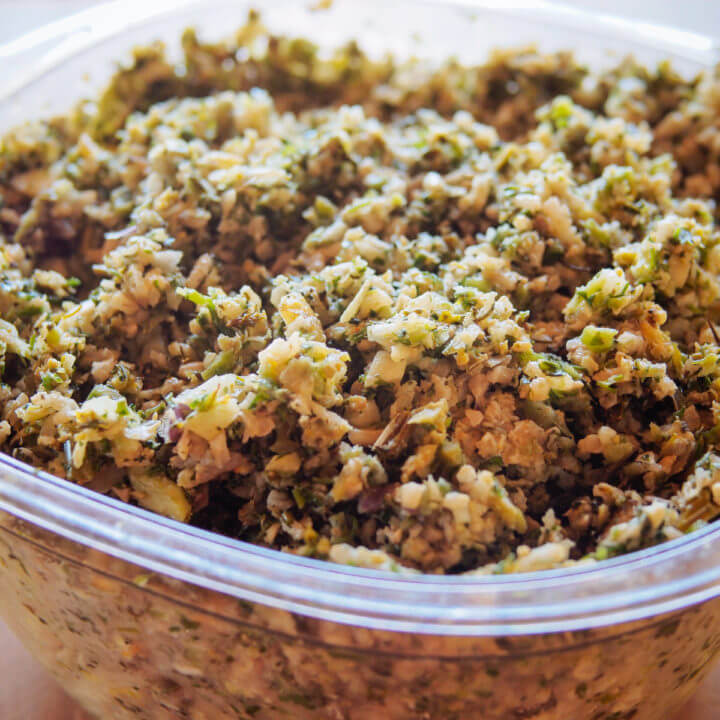
Here's a handy guide to help you make your own dog food at home with fresh, whole ingredients you can recognize. Use it to mix and match ingredients as needed to meet your dog's dietary needs.
Ingredients
- 2 tablespoons coconut oil
- Ground turmeric for seasoning
- 2 1/2 pounds raw boneless meat of choice
- 1 pound raw vegetables of choice
- 1 pound cooked complex carbohydrates, cooled
- 4 clean crushed eggshells
Instructions
- Heat a large skillet over medium-high heat. Melt the coconut oil in the skillet and swirl it around to coat the surface.
- Season the meat generously with ground turmeric. Add the meat to the skillet and saute on both sides until fully cooked (time varies according to the thickness and type of meat used).
- Transfer the meat to a cutting board. When cool enough to handle, coarsely chop the meat into 1-inch chunks. Set aside.
- Coarsely chop the vegetables into 1-inch chunks. Set aside.
- If your cooked complex carbohydrate is a grain (like rice) or legume (like lentils), you can leave it whole. If it's a starchy vegetable (like sweet potato), coarsely chop it into 1-inch chunks and set aside.
- Add the eggshells to the bowl of a food processor and pulse until finely crumbled.
- Add the meat and vegetables and pulse until finely chopped. (You may work in batches, if necessary.)
- Add the cooked carbs and pulse a few times to combine. You want the mixture to be fluffy, not mushy.
- Transfer the mixture to a large bowl, cover, and refrigerate. (Alternatively, you can transfer all or part of the mixture to a resealable plastic bag and freeze for future use. Thaw the frozen food in the refrigerator before using.)
- To serve, scoop the food into a bowl for your dog. (See Notes below for recommended serving amounts.)
Notes
Suggestions for Ingredients
- Meats: chicken, turkey, beef, bison, pork, lamb, venison
- Vegetables: broccoli, cauliflower, carrot, zucchini, summer squash, spinach, kale, collard greens, chard, thawed frozen peas
- Complex carbohydrates: brown rice, wild rice, quinoa, lentils, oatmeal, sweet potatoes, winter squash
Recommended Serving Amounts
- 2 pounds of food per day for a 100-pound dog (2 percent of body weight)
- 1 to 1 1/2 pounds of food per day for a 50-pound dog (2 to 3 percent of body weight)
- 1/2 to 3/4 pound of food per day for a 25-pound dog (2 to 3 percent of body weight)
- 5 to 6 1/2 ounces of food per day for a 10-pound dog (3 to 4 percent of body weight)
This information is not intended to replace professional medical advice. Every dog's dietary needs are different. Please consult with your veterinarian and use personal judgment when applying this information to your own dog's diet.
View the Web Story on homemade dog food.
















Chantel Pennell liked this on Facebook.
Ellen Phillips liked this on Facebook.
Michelle Highfill liked this on Facebook.
Best Bully Sticks liked this on Facebook.
Anita Morton liked this on Facebook.
Gwenyth Elliott liked this on Facebook.
Melissa Caughey liked this on Facebook.
Sam Sharman-Dunn liked this on Facebook.
Amanda Ramczyk Houston liked this on Facebook.
Linda Morse liked this on Facebook.
Nikki Oldenburg liked this on Facebook.
Randall S. Winkler liked this on Facebook.
Greg Hadel liked this on Facebook.
Elizabeth Dodge liked this on Facebook.
Annette Corona liked this on Facebook.
Our pug is only 9 weeks old. I’ve started making her food. Thanks for all the great info. How many egg shells do I put in the mix?
It depends on how large of a batch of food you’re making. I usually add 2-3 eggshells and pulverize them in the food processor before adding the other ingredients.
Yes, I caution against thiosulphate in my post. It’s most prevalent in onion, and found in only trace amounts in garlic (so use your best judgment and don’t feed large amounts of garlic to your dog). Thiosulphate is NOT present in grapes or raisins.
As with all foods, feed in moderation and always be aware of what your dog is eating.
The tumeric changed the chicken to a yellow color. Is that normal or did I add to much? The chicken I used was a whole chicken from our Roos we had. We had them in the deep freezer not sure if that matters. Just want to make sure it won’t make my babies sick :(. Thank you!
Yes, turmeric will tint your food yellow. This is perfectly normal!
Rather than cook their meat, it’s best just to give it to them raw. Also I would not give them any grains be it rice or potato. I give ours raw pastured organic eggs (ours if they are laying), raw milk kefir I make myself, home made bone broth for minerals.
I don’t follow a raw meaty bone diet, but for others who do, I recommend feeding bones from only pasture-raised meats.
Learn to make your own nutritious dog food at home. The Story of Bug (and the Homemade Diet I Feed My Dogs) http://t.co/YoIFhh64zP #recipe
Hi Linda, have you looked into bone broth? I make it for a German Shepherd-mix rescue with some health issues and it’s done wonders for her. I use pastured beef bones (usually from leftovers) in a stock pot for 24-48hrs with Apple cider vinegar. Might be cheaper/healthier for your babies. It’s really done wonders for my girl… Cheers
I adore bone broth! It was my family’s cure-all when I was growing up. I don’t make it as often as I’d like, but I should. Thank you for the reminder.
Thanks so much for this blog entry. I have two dachshunds, one girl with a bit of back trouble (age 8) and a boy (pudgy puppy, age 5) who tends to gain weight quickly if I’m not careful what he eats. I’ve tried a variety of good quality dry dog foods, mixed with a bit of hot water and a TB of canned food for taste, just can’t seem to get a good mix for the two of them. I got the ingredients to make them some food and ordered supplements (arriving today),so tonight will be the big night for our first homemade food. One thing I don’t have is a digital scale, I’m wondering what size scoop you use for their food – 1/3 cup, 1/2 cup? I figured out the portions to make a week’s worth of food for them, just trying to get an idea how that breaks down to two daily meals. Thanks again for this informative post, I know my darlings are going to be so grateful and much healthier.
I give them a 1/2 cup, twice a day, of the food you see in the photos above. (The pugs weigh about 20 lbs.) Best of luck with your babies’ new diet!
The Story of Bug (and the Homemade Diet I Feed My Dogs) http://t.co/dag0quQOUr < TY for RT! @FlowerChick826
Great blog entry! I’ve been a raw feeder since 1997 and happily got 3 racing greys and 2 regular dogs to 14 before they succumbed to something nasty. ‘Course, I’ve had a bone cancer greyhound at 5, too…so there you go. The tumor factories they’ve turned racing greyhounds into is a tough genetic thing to overcome. But we TRY!
Exactly, anything to make their lives as wonderful as possible while they’re with us! It’s a win-win!
Homemade dog food can be fresh and delicious like human food. The Story of Bug (and the Homemade Diet I Feed My Dogs) http://t.co/fiLfh1Xw1e
Want to make your own dog food at home? How I make mine: The Story of Bug (and the Homemade Diet I Feed My Dogs) http://t.co/NfOZGeej0L
My formula for homemade dog food: The Story of Bug (and the Homemade Diet I Feed My Dogs) http://t.co/cfl5Ja6LG6
Hi there!
Just a tip I think you should look into (if you haven’t already) – I have known a few dachshund owners with older pups that were told their dogs would NEVER walk again due to hip dysplasia… and each one that tried acupuncture CURED them. It sounds crazy but it’s true. Three different owners + older dogs. Obviously they still had symptoms they had before becoming immobile, but it totally reversed the worst of their conditions and made them more able-bodied !
I hope maybe you can try this + give your pup some more comfort, although she seems SO happy + fortunate to have you!
Also… thank you so much for this guide. We are thinking of taking the plunge to homemade food for our own pup soon. You make it seem so doable – and even if its tough, its still totally worth it right?
I’ve considered acupuncture (my mother-in-law used it for her cat) but it’s something I should definitely read more into. We’re always looking for ways to keep her as comfortable as possible. She gets daily massages and sometimes, she’ll even float in the hot tub with us! (Before it heats up too much, that is.)
I think you’ll have no problem switching to homemade food, it’s incredibly easy and yes, totally worth it. 🙂
I’ve been cooking for my dogs for the past 5 or 6 years. At first, I worried that they would be lacking nutrition that I believed would be magically found in commercial (high end) food. Now, I use a special powder mix and this addresses my concerns. I notice that my dogs used to have tear staining and smell. But on homemade food, it never happened. Also, I thought too much broccoli/cauliflower was bad because of the gas and twisting their intestines?
Lastly, I just wanted to offer up 3 tips. I now throw it all in the crockpot as this is soooo much easier. Then I use a stick blender. Also, it freezes well so I can make one batch that an last about a month. Investing in a set of glass storageware would be helpful.
For the carbs, I switch between quinoa, oatmeal and brown rice. Oatmeal is a great alternative bc it’s not as $$ as quinoa and it still offers up lots of nutrition. Thanks for sharing your story b
The fiber and nutrients in broccoli (and other brassicas) far outweigh any potential gaseous episodes. 🙂 And they’re not always the main culprits of gas — whole grains are sometimes responsible for it, too. As with any and all food, moderation and variety is key. I typically add at least 5 different vegs/fruits to my dogs’ food.
I’ve had great success tossing in a bag of frozen berries too. I love the giant frozen organic veggie bags from costco!
Frozen fruits make great summer treats for dogs!
Homemade dog food is easy to make and potentially lifesaving. The Story of Bug (and the Homemade Diet I Feed My Dogs) http://t.co/xG7SmkJj36
RT @theGardenBetty: Homemade dog food has given me a few extra years with my pug. The Story of Bug (and the Homemade Diet I Feed My Dogs) h…
RT @adamcortell: The Story of Bug (and the Homemade Diet I Feed My Dogs) http://t.co/LNQQr9rETP From Garden Betty by Linda Ly
The Story of Bug (and the Homemade Diet I Feed My Dogs) http://t.co/LNQQr9rETP From Garden Betty by Linda Ly
Great information! I have 2 pugs, 5 and 7, and recently started giving them a raw food diet. I might try giving the girls some new veggies 🙂
Mine are always perched right on my feet, under the cutting board, when I’m prepping in the kitchen. 🙂
Thank you for sharing your doggie diet! We’ve had up to 7 canine kids at once. Now we have to 5 due to their aging. I’ve been through a lot of different diets with so many, changing needs, and food quality. The last fuzzy friend we bid farewell to, led me to feed a more homemade diet. We used Dr. Harvey’s as the base for it’s convenience and cost to feed our 80+lbs. husky/malamute who had severe hip and UT issues at approx. 16yo. While he was too far gone to see as much of a bounce-back that your girl did, we worked with our holistic vet and his diet to be able to give him a comfortable last few years. I’ve found a kibble that works for the rest of them for now and still use the Harvey’s as a treat to entice them to take their meds. Not spoiled or anything—they get all kinds of stuff that we eat, too. The huskies are picky, but my 14yo. Golden loves carrots and seaweed snacks. Thanks again for sharing to give me some new ideas.
I don’t think homemade/human food is spoiling your dogs at all — it’s just giving them the good, wholesome food they deserve! Good luck with your brood!
I, too, cook for my doggies and wouldn’t have it any other way. It all started with a very sick boy (a Toy Manchester) in intensive care for a couple of weeks. Chemo left him so thin and malnourished. We started with scrambled eggs and fruit/easy to digest veggies. That was 5 years ago…today he is a teenager and a perfectly healthy canine. Actually, your recipe for feeding success is wonderful. Ours is very similar. I put lean meat in the slow cooker with sweet potatoes and go from there. Love those doggies!
They’re our babies, that’s for sure! 🙂
Homemade dog food has given me a few extra years with my pug. The Story of Bug (and the Homemade Diet I Feed My Dogs) http://t.co/dag0quQOUr
I’ve been making my dogs’ food for the past 4 years. A combination of chicken, rice, yams, pumpkin and salmon oil. Thanks for the tip on broccoli. The boy had a broken hip that didn’t heal properly while he was in the pound so the vet said he might be prone to arthritis later in life.
Massages, memory foam beds, and heating pads in winter help too. It’s like a dog spa in my home. 😉
Thanks so much for this, Linda! I have a husky and he needs a grain-free diet. I’ve tried so many store brands but his weight continues to climb. I’m worried about his health in the future since I don’t want him to experience heart problems and such. I’ve been thinking about making his food at home so this is a great resource for me. Thanks! (P.S. Bug is beautiful!)
A healthful grain-free diet is so much easier when you can make it at home and monitor what goes in it. I know that frustrated feeling when nothing from the store works. Good luck with your baby!
Blogged on Garden Betty: The Story of Bug (and the Homemade Diet I Feed My Dogs) http://t.co/0eYETTZCbn